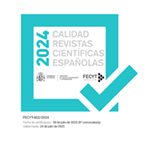Gender and geographic diversity in the editorial boards of communication journals
Abstract
The present research explores the geographical and gender diversity in the editorial boards of 40 journals indexed in the JCR (Journal Citation Report) ranking between quartile one (Q1) and quartile (Q2) in the category of communication during 2015. A cluster analysis is first designed to group the journals based on three factors: the nationality and gender of the editorial boards and the impact factor of the journal. Through a logistic regression the article explores the probability of inclusion of non-US researchers and women in editorial boards based on seven independent variables: the gender and nationality of the editor, the total number of editorial members of the journal, the impact factor, the affiliation of the journal to an academic association, the publishing house and its central theme. The study shows an association between the probability of inclusion of non-US researchers and all the predictor variables. In addition, the article reveals an association between the probability of inclusion of women and predictor variables such as the nationality of the editor, the publishing house and the central theme of the journal. It is concluded that geographic and gender standardization jeopardize the acquisition of global knowledge and challenge scientific plurality as a constitutive value of academic progress.
Downloads
Article download
License
In order to support the global exchange of knowledge, the journal Estudios sobre el Mensaje Periodístico is allowing unrestricted access to its content as from its publication in this electronic edition, and as such it is an open-access journal. The originals published in this journal are the property of the Complutense University of Madrid and any reproduction thereof in full or in part must cite the source. All content is distributed under a Creative Commons Attribution 4.0 use and distribution licence (CC BY 4.0). This circumstance must be expressly stated in these terms where necessary. You can view the summary and the complete legal text of the licence.










